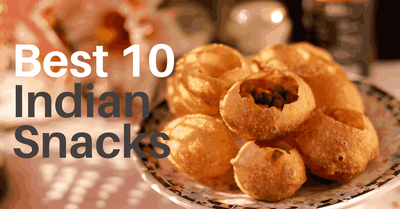Preserving frozen Indian foods during travels across Australia's challenging landscapes can be a daunting task.
If you are backed with some careful planning and the right equipment, you can savor the delightful flavors without compromising, even in the heart of the bush.
The food you bought from your best online grocery store should be in best condition till you reach your destination. But there are a lot of challenges you have to face.
Challenges of Travelling with Frozen Delicacies
Embarking on a journey across Australia with a stash of frozen delights introduces a unique set of challenges that every savvy traveler must confront.
Navigating the vast and diverse terrains of the continent requires meticulous planning to ensure your frozen Indian treasures reach their destination unscathed.
Unforgiving Landscapes
Australia's varied landscapes, from arid deserts to lush rainforests, demand careful consideration when transporting frozen goods.
Extreme temperatures, especially in remote areas, can jeopardies the integrity of your carefully curated Indian culinary treasures.
Limited Access to Supplies
Small towns with sparse grocery options can pose a significant challenge. When you're in the middle of nowhere and your frozen stash is at risk, having a strategic plan becomes paramount.
The limited availability of specialty ingredients adds an extra layer of complexity to the journey.
Storage Constraints
While the allure of exploring the great outdoors is undeniable, it often means limited storage space.
Tightly packed vehicles or compact camping setups require thoughtful organization to ensure that your cooler, laden with frozen samosas and naan, remains accessible and well-preserved.
The Battle Against Thawing
The relentless Australian sun can turn your cooler into a miniature oven, putting your frozen food at the mercy of thawing. Keeping your culinary treasures frozen amid the heat is not just a preference but a necessity to avoid a messy and less appetizing culinary experience.
Addressing these challenges head-on will set the stage for an unforgettable journey, where every frozen samosa and naan remains a delightful reminder of the rich Indian flavors amidst the rugged beauty of Australia.
Tips to Travel with Frozen Food
Tip 1: Choose Commercial-Grade Coolers for Extended Trips
When undertaking long journeys through harsh conditions, the average foam cooler simply won't cut it.
Invest in ultra-durable hard-shell coolers explicitly designed to maintain freezing temperatures, such as those from reputable brands like Yeti or Pelican.
Premium models can keep contents icy for up to a week, a crucial feature when transporting heat-sensitive items like samosas and naan, especially in areas where stores are scarce.
For those who prefer a lighter option, brands like OtterBox offer soft-sided coolers with ample insulation and convenient expandable pockets for food organization. However, it's important not to overstuff the cooler, as it can affect its cooling capacity.

Tip 2: Freeze A Surplus of Ice Packs Based on Trip Duration
In preparation for your journey, calculate the required ice packs based on the total travel days and the volume of frozen Indian food.
Freeze additional packs as backups the day before departure. Arrange the first layer of packs under and around the foods to ensure thorough chilling from all sides.
Durable rectangular blocks offer unparalleled freezing intensity, while gel packs that mold tightly around curries provide concentrated coverage. It's advisable to have reserves thawing in the freezer for quick swaps if necessary.
Tip 3: Establish a Structured Cooler Packing Formation
Randomly tossing foods into the cooler can lead to food spoilage and cross-contamination. It is important to pack foods carefully to ensure that they stay fresh and safe to eat. Here are some tips for packing Indian food in a cooler:
- Place sturdy, flat items like frozen naan or roti at the bottom of the cooler to support stacking side dishes on top.
- Wrap samosas individually in foil to prevent freezer burn.
- Group similar curries or kebabs and clearly label their lids.
- Wedge additional ice packs along the walls and between food layers.
- Top off with a final layer of ice packs securely positioned.
By following these tips, you can help ensure that your Indian food stays fresh and delicious for your picnic or potluck.

Tip 4: Monitor Freezer Temp Status with a Digital Thermometer
Even the most robust coolers can eventually succumb to Australia's heat. Carrying a slim thermometer provides crucial insights:
- A temperature of 0°F (-18°C) or below indicates items are fully frozen. This is the ideal temperature for storing food for long periods.
- Approaching 32°F (0°C) signals that thawing is imminent. This is the temperature at which water freezes, so food that is stored at this temperature will start to thaw and spoil.
- Anything over 40°F (4°C) indicates that consumption should happen as soon as possible. This is the temperature at which bacteria start to grow rapidly, so food that is stored at this temperature should be eaten within a few hours.
Regular temperature checks enable quick responses before irreversible thawing occurs. By checking the temperature of your food regularly, you can ensure that it is always safe to eat. It is important to note that these are just general guidelines, and the actual safe storage temperatures for food may vary depending on the type of food and the length of time it will be stored. It is always best to check the manufacturer's instructions for specific storage recommendations.
Tip 5: Follow Proper Refreezing Guidelines
On extended trips, some thawing is expected. If cooked curries or kebabs rise above 40°F internally, consume them within 2 hours. This is because bacteria can grow rapidly at temperatures between 40°F and 140°F.
Uncooked samosas can often be safely refrozen if they never reach room temperature. This is because bacteria cannot grow in the freezer. Adhering to food safety rules is crucial to prevent illnesses.
Food poisoning can cause a variety of symptoms, including nausea, vomiting, diarrhoea, and abdominal cramps. In severe cases, it can lead to hospitalization or even death.

Tip 6: Use Appropriate Freezing and Packing Methods Initially
Properly preconditioning Indian items sets the stage for smoother transportation:
- Pre-freezing naan slices overnight will prevent them from clumping into a solid block. This is because when naan is frozen, the water molecules inside it expand and form ice crystals. These ice crystals can then break down the structure of the naan, causing it to become crumbly and unappetizing. By pre-freezing the naan slices, you can prevent these ice crystals from forming, which will help to keep the naan soft and pliable.
-
Portion samosas or curries into durable, leak-proof containers before freezing to reduce freezer burn. Freezer burn is a condition that occurs when food is exposed to air while it is being frozen. This can cause the food to become dry, discolored, and crumbly. By portioning the samosas or curries into durable, leak-proof containers, you can help to prevent them from coming into contact with air, which will help
to reduce the risk of freezer burn. - In addition to these tips, it is also important to label the containers with the date that the food was frozen. This will help you to keep track of how long the food has been frozen and ensure that it is consumed within a safe time frame.
Tip 7: Safeguard Against Leaks from Melted Ice Packs
Expect ice packs to eventually melt. Be prepared for the inevitable:
- Choose coolers with inner plastic linings or line more porous models with waterproof casings. This will help to prevent the ice packs from melting and making a mess in your cooler.
- Place ice packs in durable, reusable plastic bags for added protection. This will help to keep the ice packs from leaking and damaging your food or other items in your cooler.
- Keep critical gear in water-resistant bags as a precaution. This will help to protect your gear from getting wet if the ice packs do melt.
By following these tips, you can help to ensure that your food and gear stay safe and dry, even if the ice packs do melt.
Tip 8: Utilize Hotel Freezers When Possible
Unless you enjoy the thought of dealing with an eerie icebox in your desert Airbnb, make use of hotel freezer access:
- Recharge ice packs to their maximum freeze capacity. This will help to keep your food and drinks cold for longer.
- Temporarily transfer some frozen goods if space allows. This will help to prevent them from thawing and spoiling.
It is important to note that you should not store any perishable items in the hotel freezer for an extended period. If you are planning on staying at the Airbnb for more than a few days, it is best to bring your cooler with you.
Tip 9: Research Airline Policies for Frozen Items
If you are jet-setting with your well-stocked cooler, avoid hassles by confirming the following policies:
- Get precise details on carry-on cooler dimensions and rules for frozen liquids. Some airlines have strict rules about the size and weight of carry-on coolers, and some do not allow frozen liquids at all.
- Check specific regulations on transporting perishables as checked baggage. Perishables can only be transported as checked baggage if they are packed in a cooler that meets certain requirements.
- Have a backup plan if your cooler gets stranded on hot tarmacs. If your cooler is delayed or stranded on a hot tarmac, your food and drinks may spoil. It is a good idea to have a backup plan in case this happens, such as bringing along some non-perishable food and drinks.
By following these tips, you can avoid hassles and ensure that your food and drinks stay fresh while you are travelling.
Tip 10: Act Swiftly if Melting Occurs
Despite your best efforts, mishaps can happen. If your icy contents start melting rapidly, you can take the following steps:
- Transfer foods to another guest's cooler as a short-term fix. This will help to keep the food cold until you can find a more permanent solution.
- Cook partly thawed samosas or kebabs over the campfire promptly. This will help to kill any harmful bacteria that may have developed in the food.
With agile troubleshooting, near disasters can become campfire tales! So don't worry if something goes wrong on your camping trip. Just stay calm and take steps to fix the problem. And then, later on, you can laugh about it around the campfire with your friends.
Here are some additional tips for preventing food from melting in your cooler:
- Pack your cooler tightly so that there is no space. This will help to keep the cold air in and the warm air out.
- Use ice packs or frozen water bottles to keep your food cold.
- Keep your cooler in a shady spot away from direct sunlight.
- If you are going to be gone for an extended period, consider using a dry ice cooler.
Summing Up
In conclusion, successfully keeping frozen food intact during travels requires a combination of quality equipment, meticulous planning, and swift problem-solving.
By investing in commercial-grade coolers, properly packing and freezing items, and staying informed about airline and freezer policies, you can ensure that your culinary delights arrive at your destination as delicious as when they began their journey.
With these 10 tips in mind, you can transform your cooler into a reliable freezer, allowing you to savor the authentic taste of Indian cuisine no matter where your travels take you across Australia's diverse landscapes. Bon voyage and happy eating!






